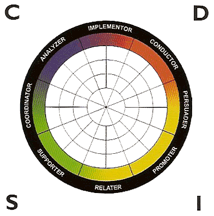 |
|
|
The History of DISC The DISC model dates back to 400 B.C. – the time of Hippocrates. He observed similarities and differences in human behavior and classified four basic types of behavior. In 1912, C.G. Jung spoke of four “types” oriented by four psychological functions: thinking, feeling, sensation and intuition. He further divided the types into “introversion” and “extroversion.” More recently, in 1928, Dr. William Moulton Marston published a book, “The Emotions of Normal People,” that describes the DISC theory in use today. Marston believed that people behave along two axes with their actions tending to be active or passive depending on the individual’s perception of the environment as either antagonistic or favorable. By laying these axes at right angles, four quadrants were formed, each denoting a separate behavioral pattern. Marston believed
that people tend to learn a self-concept, thus allowing
|
|
 |
|
|
Home ▪ Sales DNA ▪ Benefits ▪ More Info ▪ FAQs ▪ About Us ▪ Contact Us ▪ Order |
|
 behaviors
to be studied scientifically and accurately categorized according to these
four patterns:
behaviors
to be studied scientifically and accurately categorized according to these
four patterns: